Uncategorized
-
America: Steeped in a Tradition of Tea
The importance of Tea in America
Tea is often associated with Great Britain, China, or even India. Few recognize its cultural importance in America. Almost 80% of consumers in America are tea drinkers, and it is a huge share of the beverage market nationally. While it has its place on the shelves commercially, it has an even greater historical importance to the United States. This post examines two key historical events and time periods, and how integral tea was to them occurring.
The Boston Tea Party
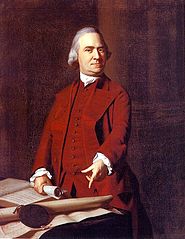 Samuel Adams, leader of the Sons of Liberty during the Boston Tea Party
Samuel Adams, leader of the Sons of Liberty during the Boston Tea PartyEveryone remembers learning about this in school, but few have a full understanding of the protest. On the night of December 16, 1773 a group called the Sons of Liberty dumped tea off of ships into the Boston Harbor. Most recall that it was a form of protest against British taxation, but the true story is much more complex.
The British passed the Townshend Acts starting in 1767. These acts levied taxes against the American colonies on a number of goods. Meanwhile, the East India Trading Company, one of the most important commercial institutions in Britain, was importing literally tons of tea to London, which then had to be exported to America. Initially, this tea was refunded some of the duties, but in the early 1700’s some of these refunds were cancelled. Suddenly, between the duties paid in London and the taxes paid by colonists in America, East India Tea was too expensive in the fledgling colonies. This led to a robust market for tea smugglers, as Americans would purchase tea from Dutch traders, despite the illegal nature.
 Artist's rendering of the Boston Tea Party
Artist's rendering of the Boston Tea PartyIronically, the expensive tea did not spark the protest. Rather it was England making the tea cheaper. The East India Trading Company had been importing vast quantities to tea in London, and with the diminished American market, much of it was sitting in warehouses. This large corporation was on the verge of financial meltdown. In some ways, what happened next was a 1700’s version of a government bailout.
The British government reissued refunds to the East India Tea Company. Additionally, they made provisions in the Tea Act of 1773 that allowed for direct shipments to America (no stops in London). Between the refunds and the direct shipments, prices of East India Tea plummeted, effectively undercutting the smugglers. This worked towards two goals for the British: save the floundering company, and also passively assert the right of the British to levy taxes on the American colonies. The Brits figured that with lower prices, there would be less opposition.
On that count, they were definitely wrong. Tea was set to be delivered to several American ports, but protests led to the ships being turned away at all ports except Boston. The people were furious about the taxation, and also because many of the colonists had worked either as smugglers, or middlemen merchants for tea coming from London. Meetings were held to discuss how to refuse delivery, but no action was taken by the colonial government. At that point, led by Samuel Adams, the Sons of Liberty took action. Many disguised themselves as Native Americans and they boarded the ships containing the dreaded tea. It took them more than three hours to dump more than 90,000 lbs of tea into the harbor. This would be more than one million dollars worth of tea in today’s money.
 A popular image encouraging the colonies to stay united
A popular image encouraging the colonies to stay unitedThe tea dumping led to the Coercive Acts (also known as the Intolerable Acts). These were a series of laws designed to punish the city of Boston, and the colony of Massachusetts, for their role in causing trouble. Among other actions, it closed the Boston Harbor until satisfactory restitution was made for the lost tea. This act enraged Bostonians and American colonists up and down the 13 colonies, and is widely considered to be one of the events that triggered the American Revolution.
The Women's Suffrage Movement
 Women protesting for the right to vote
Women protesting for the right to voteThe movement for the women’s right to vote took place more than 100 years after the Boston Tea Party but was every bit as important. During the late 19th century, women had very few rights, and certainly were not allowed to vote. One issue that made it difficult to gain any traction in this movement was that women were not really able to congregate without supervision. During this time, there were very few opportunities for women to meet in private. Even going to lunch required a chaperone.
Some of this began to change with the popularity of tea houses. As teahouses began springing up, some were designed specifically for women. Finally, a place existed for groups of women to get together without their husbands or fathers overseeing their every word. These rooms turned out to be a starting point for the suffragette movement. Women meeting over tea began to talk with one another, and question why they were being treated as second class citizens. One such meeting took place at a specially designed tea house on a wealthy woman’s property.
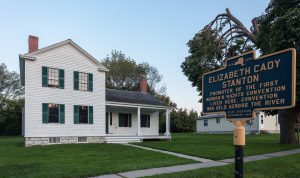 Elizabeth Stanton's Home
Elizabeth Stanton's HomeElizabeth Cady Stanton was living in Seneca Falls, NY. She had a social visit in her tea house with Lucretia Mott, Martha Wright, Mary Ann McClintock, and Jane Hunt in July of 1848. The women had all previously dabbled in social activism, and decided to put on a convention to discuss women’s rights and social issues. This was the birthplace of the Seneca Falls Convention. They set up the convention with only five days of formal planning, a small newspaper ad, and word of mouth advertising.
At this convention, the Declaration of Sentiments were ratified. Modeled after the Declaration of Independence, these were a list of grievances. The ninth and most incendiary one referenced women’s right to vote. It was ratified by the women at the convention, and Stanton became a lifelong fighter for women’s voting rights. Finally, the 19th Amendment to the U.S. Constitution was ratified in 1920, and women were given the right to vote. Stanton did not live long enough to see the historic day. In fact, only one of the original signers of the Declaration of Sentiments was alive for the ratification. Charlotte Pierce, who was 19 at the time of the Seneca Falls Convention, was 90 when the women’s suffrage movement finally prevailed. And to think that it all began with a simple cup of tea among friends.
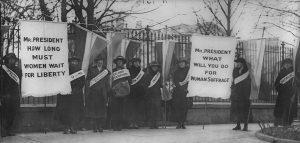 Women's Suffrage protesters. They were finally granted there wish with the 19th Amendment in 1920.
Women's Suffrage protesters. They were finally granted there wish with the 19th Amendment in 1920.References
http://www.historynet.com/seneca-falls-convention
http://avalon.law.yale.edu/18th_century/townsend_act_1767.asp
http://avalon.law.yale.edu/18th_century/boston_port_act.asp
http://www.eyewitnesstohistory.com/teaparty.htm
http://www.history.com/topics/american-revolution/boston-tea-party
-
5 Scientific Studies about Chamomile
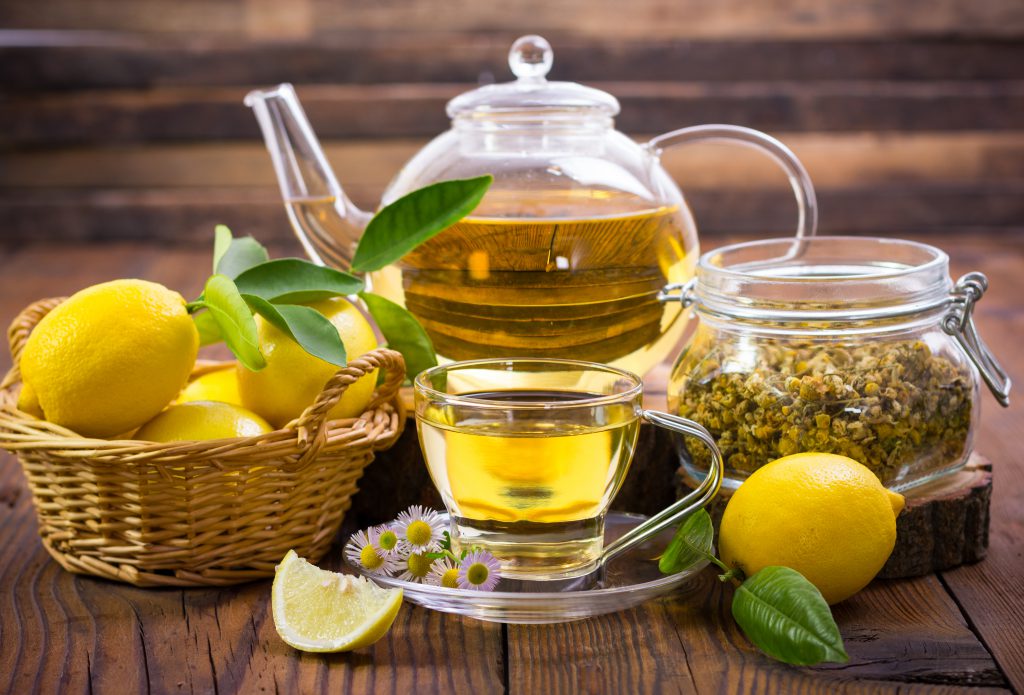 General Anxiety Disorder
General Anxiety DisorderChamomile has long been thought to have a calming effect on those that drink it. This is one of the reasons that it is a recommended nighttime beverage, as it helps to relax the drinker. A study was done to look further at these relaxation properties, and see if they had a significant effect on individuals suffering from General Anxiety Disorder. General Anxiety Disorder affects roughly 3% of the population, or almost 7 million people (ADAA).
In this study, published in the International Journal of Phytotherapy and Phytopharmacology, individuals were put into a test group and control group. The control group was given a placebo, while the test group was given chamomile extract, over the course of an eight week period. The findings were enlightening. Because GAD has subjective symptoms, patients used the General Anxiety Disorder scale to evaluate their symptoms. The scale is shown here. Basically, individuals rate a number of symptoms on a 0-3 scale. These are in reference to symptom prevalence over the previous two weeks. 0 means not experienced at all, while 3 means experienced daily.
The experimental group in this study saw their GAD score decreased by 8.4. The findings were statistically significant compared to the control group. This was strong evidence that the chamomile extract was effective in reducing the symptoms of General Anxiety Disorder.
Mortality Rates
 In many countries, consumption of chamomile tea is a daily ritual, especially among older adults. In April 2015, a study was published that sought to quantify the benefits of this practice. While the Japanese are renowned for their tea drinking, this study, published in the Oxford Academic, instead focused on Mexican Americans above the age of 65.
In many countries, consumption of chamomile tea is a daily ritual, especially among older adults. In April 2015, a study was published that sought to quantify the benefits of this practice. While the Japanese are renowned for their tea drinking, this study, published in the Oxford Academic, instead focused on Mexican Americans above the age of 65.The results were very eye-opening. Overall, there was a 29% reduction in mortality among all adults in the study. There was a statistically significant drop in mortality specifically in female subjects. This data is very much in line with other studies done in Japan and Asia that have pointed to extended life for older adult women that drink chamomile regularly.
The study is a great jumping off point for the study of chamomile and its effects, but needs follow up for greater results. This study had thousands of people, which helps strengthen the results. It was done by self-reporting, which meant limited information about quantity and exact type of chamomile tea was available to the researchers. Also, self-reporting studies can have an inherent bias, as people are not always accurate or honest in their reports.
The clinicians involved with the study did find the results to be significant. They indicated that this study provided moderate evidence of a decrease in mortality among the general population, and, in conjunction with previous studies, strengthened the evidence for decreased mortality in women that consume chamomile tea.
Mood and Relaxation
Chamomile is a common relaxant, though, as outlined above, is used predominantly by older adults. This study sought to find out the effects of chamomile tea on young adults. Specifically, college age students between the ages of 18-25. This study was conducted by the Department of Psychology at Northumbria University, and was published in the
 September issue of Plant Science Today. They had three different groups: one group that drank chamomile tea, one group that drank peppermint tea, and one group that drank hot water (control group). They then tested these students in a number of areas over an eight week period. They took some quantitative cognition tests, but also some qualitative relaxation and mood surveys.The findings of the study confirmed much of what was already believed about the two different teas. The peppermint tea increased cognition in a statistically significant way over both the chamomile and control group. Meanwhile, the chamomile tea showed significant results on the subjects’ calmness and other positive mood traits.
September issue of Plant Science Today. They had three different groups: one group that drank chamomile tea, one group that drank peppermint tea, and one group that drank hot water (control group). They then tested these students in a number of areas over an eight week period. They took some quantitative cognition tests, but also some qualitative relaxation and mood surveys.The findings of the study confirmed much of what was already believed about the two different teas. The peppermint tea increased cognition in a statistically significant way over both the chamomile and control group. Meanwhile, the chamomile tea showed significant results on the subjects’ calmness and other positive mood traits.The study set out to conduct an experiment about widely held beliefs for peppermint and chamomile tea. It turns out, the common knowledge on these teas has strong scientific evidence on its side. It does seem that peppermint aids in cognition and that chamomile aids in relaxation and other positive mood traits. This is a great reminder for young adults that drinking tea can be an effective way to help with academic studies, and also anxiety and stress.
Diabetes Help
This study was published by the American Chemical Society in 2008. It again looked to scientifically study commonly held beliefs about chamomile. In this case, it was looking at the way hot water chamomile extract could affect diabetic complications, or help in the prevention of diabetes.
 Diabetes patient measuring glucose level blood test
Diabetes patient measuring glucose level blood testIt is widely known that herbal remedies and teas can have influences on a variety of diseases and disorders. Much of this comes through their reactions with different enzymes, though it is unknown exactly how these interactions occur. This study, performed on mice, looked at chamomile as a whole, but also several chemical compounds found within chamomile. Specifically, they looked at umbelliferone, esculetin, luteolin, and quercetin. They studied each of these compounds separately, but also looked at chamomile extract as a whole.
The results were very encouraging. The extract, esculetin, and quercetin all showed moderate inhibition of sucrose. When put through a sucrose loading test, esculetin was able to fully suppress hyperglycemia after both 15 minutes and 30 minutes. The chamomile extract also helped in suppressing hyperglycemia, but not quite as effectively as the isolated esculetin.
The chamomile extract was shown to be a potent inhibitor against aldose reductase (AL2R). It was found that both the extract and several of its underlying compounds could “significantly inhibit the accumulation of sorbitol in human erythrocytes.
The final prognosis from the study was, as always, that further studies are certainly warranted. They did say that this study provided strong evidence that consuming chamomile tea each day could contribute to the prevention and or progress of certain diabetic complications. This is very encouraging. It shows that the western scientific community is beginning to recognize the incredible power of herbal remedies and herbal teas.
Primary Dysmenorrhea
This study in the Iranian Journal of Obstetrics, Gynecology, and Infertility tested in the effect of chamomile tea on primary dysmenorrhea. Primary Dysmenorrhea is an extremely prevalent condition found in menopausal women. It involves severe pain in the lower abdomen, which sometimes can spread to the thighs. It can often
 be known as cramping, and is experienced by up to 90% of women during menstruation. Luckily, there are already several remedies available to relieve the symptoms of these cramps. Most commonly, women are given non steroidal anti-inflammatory medications. These are usually quite effective, but roughly 1 in 10 women do not respond to these measures. For these women, alternatives are needed.
be known as cramping, and is experienced by up to 90% of women during menstruation. Luckily, there are already several remedies available to relieve the symptoms of these cramps. Most commonly, women are given non steroidal anti-inflammatory medications. These are usually quite effective, but roughly 1 in 10 women do not respond to these measures. For these women, alternatives are needed.This study looked to see if chamomile tea could be an effective alternative treatment for primary dysmenorrhea. To do this, 80 women at the university were split into a control group and experimental group. The experimental group was asked to drink two cups of chamomile tea per day the week before their menstruation, and the first five days of their menstruating. This was continued for three months. Individuals then responded to surveys after their first and third menstrual period, evaluating stress, pain, and anxiety.
The results were astounding. Using a summation of means method to compare the control and experimental groups, there was extremely strong evidence that drinking chamomile tea reduces the symptoms of Primary Dysmenorrhea (P<.001). The researchers thus concluded that chamomile tea is an effective therapy in reducing the pains of primary dysmenorrhea and the subsequent psycho-social problems.
This study is a great reminder of the unexpected benefits of chamomile. Cramping is something the vast majority of women deal with during their menstrual cycle, and their is now strong evidence that chamomile tea drunk daily can greatly reduce the pain and anxiety this causes. This is especially important for women that have not found relief with previously accepted methods of pain reduction.
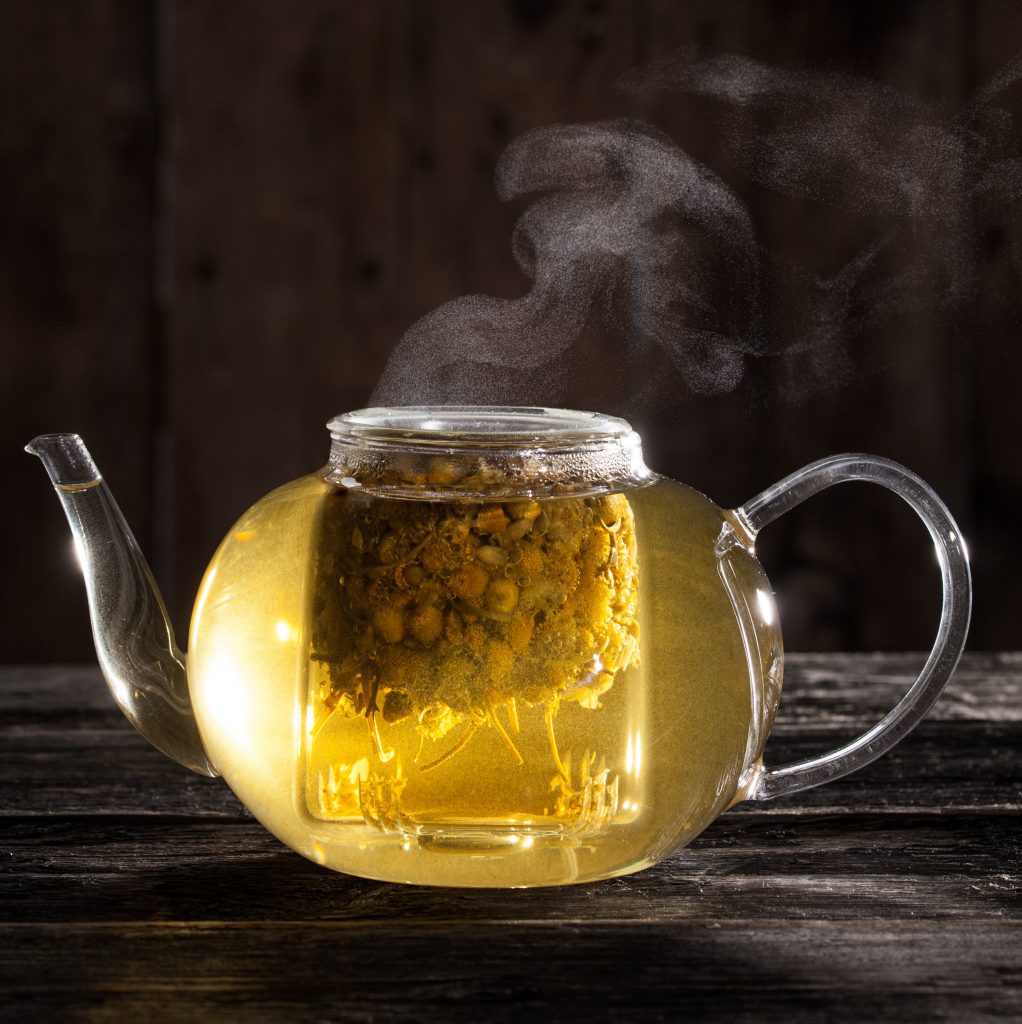
DISCLAIMER: While the studies mentioned above are published scientific studies, US-Wellness does not make any claims as to possible medical benefits of chamomile. These studies are linked to for reference, but consumers should always seek the advice of a licensed medical doctor before undergoing treatment, herbal or medicinal, for any condition. U.S. Wellness does not claim that chamomile tea is a treatment for any illness.
-
Real Science- 5 Incredible Facts about Calendula
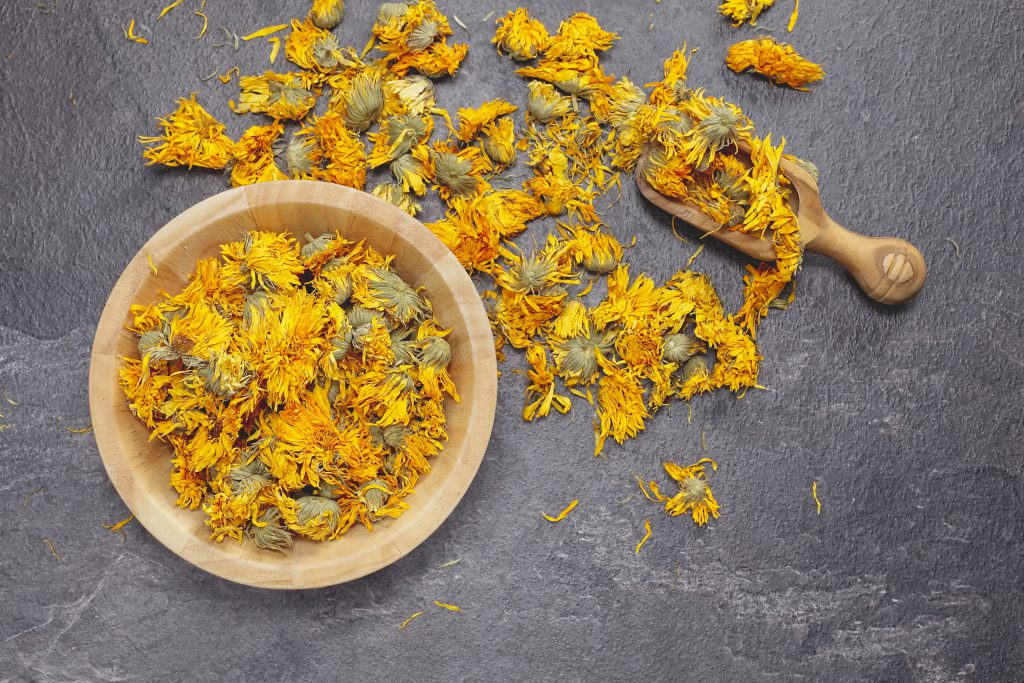
Calendula Officinalis is an amazing plant. Known commonly as Potted Marigold, the marigold, or simply Calendula, it has wondrous properties that have been utilized as herbal remedies for hundreds of years. Currently, new scientific testing has confirmed many of these beliefs about Calendula and its pharmacological properties. The extract has flavonoids, saponins, and polysaccharides that have all been shown to have some positive effects. Different medical experiments have taken the extracts from the plant to try to isolate the positive effects.
Skincare Help during Radiation Treatment
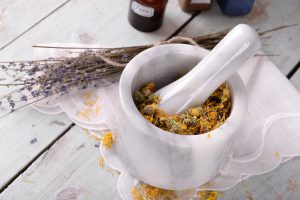 Different dried herbs and mortar on table close up
Different dried herbs and mortar on table close upFor women undergoing radiation treatment for breast cancer, there has always been a desire to have a preventive topical cream that could help reduce the dermatological effects. Specifically, doctors wanted something that could reduce acute dermatitis during these periods. For a long time, the only available option was a topical cream with Trolamine. A study in the Journal of Clinical Oncology was designed to test a topical cream made from the extract of Calendula Officinalis and the cream made from Trolamine. The findings were astounding. Across the board, the Calendula extract cream was superior. The number of patients exhibiting grades two or three skin toxicity was significantly lower in the group administered the Calendula extract in a statistically significant way (P<.001). Additionally, these patients reported less discomfort, and had fewer instances of suspension of therapy due to skin toxicity. All of this combines to show that early medical practitioners were certainly on to something. This is good evidence that Calendula has positive effects on the skin. This scientific study shows that, during radiation treatment, Calendula can be greatly helpful in reducing skin problems. There is also an implication that, as a whole, Calendula has some powerful properties for dermatological care.
http://ascopubs.org/doi/full/10.1200/jco.2004.07.063
Help for Cuts or Wounds
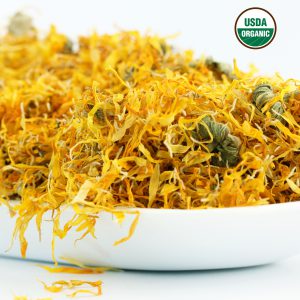
Calendula has often been used as a do it yourself salve or wound cover. This has been a practice spanning hundreds of years, but they are beginning to find evidence that this has verifiable scientific results. In a study done on laboratory rats, calendula extract was tested in wounds. These animals were given induced wounds, and some were treated with calendula officinalis extract. What they found was that the animals given the extract showed marked improvements in regeneration and epithelialization. The scientist working on the study believe the effect is a result of intensified metabolism of glycoproteins nucleoproteins, and collagen proteins during tissue regeneration. This study was published in the Acta Physiologica et Pharmacologica Bulgarica.
http://europepmc.org/abstract/med/7185264
Anti-Inflammatory and Anti-Tumor Properties
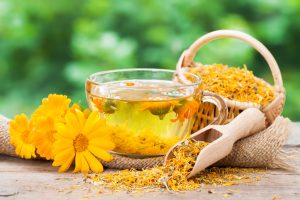 Cup of healthy marigold tea and calendula flowers.
Cup of healthy marigold tea and calendula flowers.This study was published in the Journal of Natural Products. It was carried out by several Japanese professors, and was to look at specific chemical compounds found in Calendula Officinalis and what those effects are. Ten oleanane-type triterpene glycosides were examined for this study along with five known flavonol glycosides. All of these were compounds found and extracted from the Calendula Officinalis family. Eight of the compounds showed a marked anti-inflammatory property. 10 of the compounds showed moderate inhibitory effects on a virus. And lastly, two of the compounds showed potent cytotoxic effects against a variety of cancer cells. These tests are still in the early stages, but are certainly promising for the future medical benefits of Calendula.
http://pubs.acs.org/doi/full/10.1021/np068016b
Anti-Fungal Properties
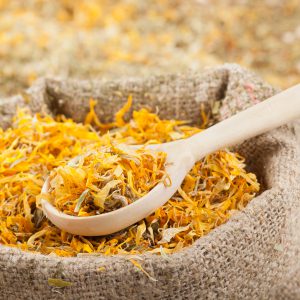 sack of healing herbs and wooden scoop, herbal medicine
sack of healing herbs and wooden scoop, herbal medicineA study published in the Brazilian Journal of Microbiology sought to examine the effects of essential oils created from Calendula on fungus. They distilled the essential oils and then injected them into several different testing specimens. The test was done using 23 different fungi strains, and the essential oil was found to be effective at reducing fungi for all 23 strains. This is a preliminary study, and clearly more work needs to be done, but this is a good sign for those that claim antifungal properties are associated with Calendula.
http://www.scielo.br/scielo.php?pid=S1517-83822008000100015&script=sci_arttext&tlng=e!n
Acne Help
A study done in the International Journal of Pharmacy and Biology examined the ways that Calendula helps acne. Interestingly, it found that many of the properties discussed above (anti-inflammatory, anti-fungus, etc) work in conjunction to have a product that helps reduce acne. Many of these effects were due to the variety of flavonoids present in Calendula. By reducing inflammation and keeping out fungus, it is not surprising that Calendula would be helpful in treating and preventing acne.
Conclusion
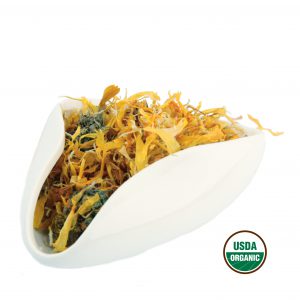 The pot marigold has long been thought of to have powerful medicinal properties. For years these ideas were left to mystics and non-western healers. The tide is turning, as many within the medical community are turning towards herbal remedies to avoid the rising tide of prescription drugs. This organic solution is
The pot marigold has long been thought of to have powerful medicinal properties. For years these ideas were left to mystics and non-western healers. The tide is turning, as many within the medical community are turning towards herbal remedies to avoid the rising tide of prescription drugs. This organic solution is starting to be studied more closely, and the results are confirming what many already thought: Calendula is a powerful flower with many positive effects on the body. Here at U.S. Wellness we offer Calendula flowers that are perfect for distilling into essential oils, making into tea, or even using for topical creams. Buy some today and experience the wonderful benefits of this all natural remedy.
3 Item(s)



